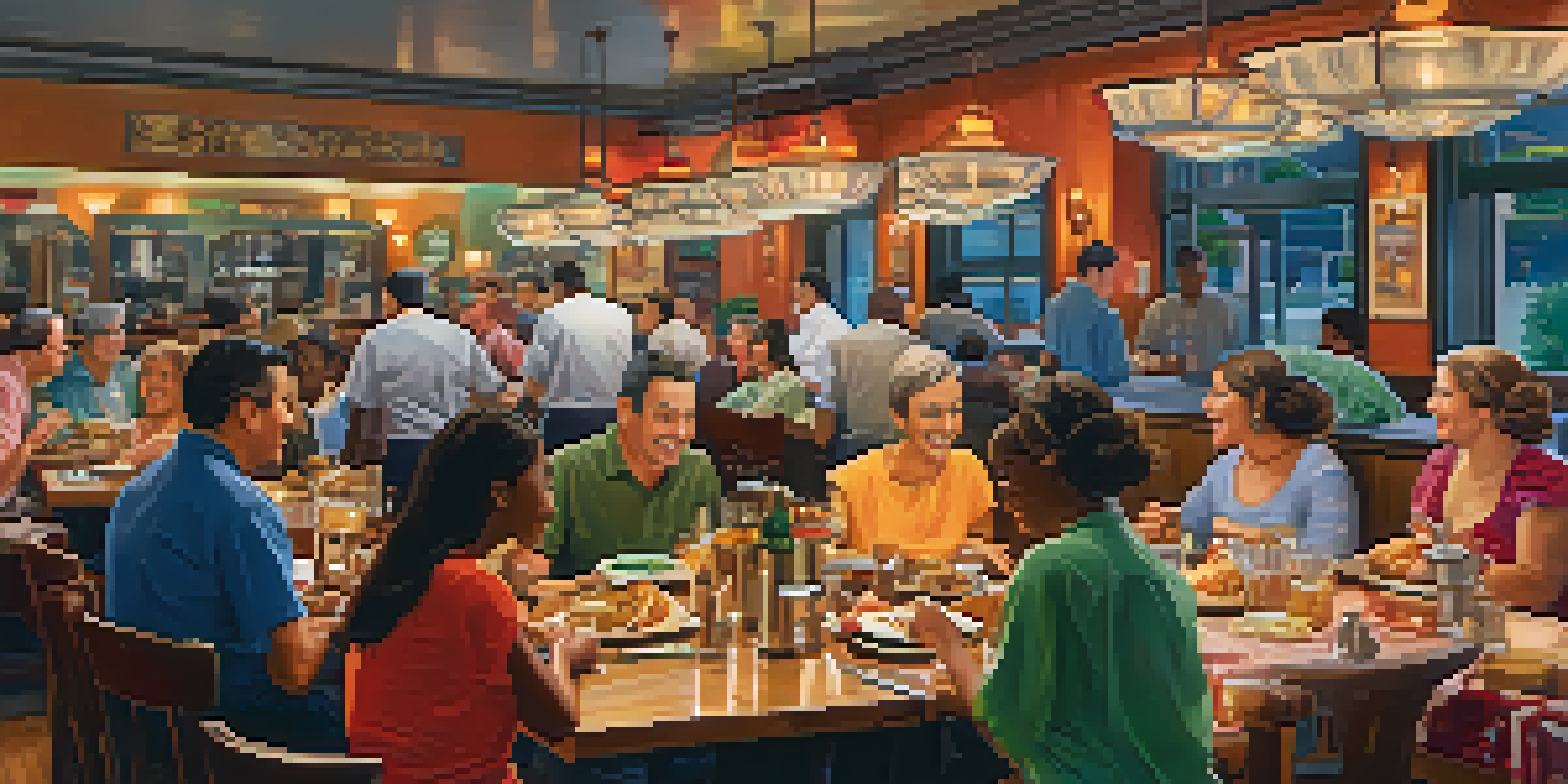Understanding U.S. Tipping Culture: A Guide for Travelers

The Basics of Tipping in the U.S.
Tipping in the U.S. is a customary practice that shows appreciation for good service. While it's not legally required, it’s a social norm that many service employees rely on for a significant portion of their income. Understanding the basics will help you navigate dining, hospitality, and other service-related experiences without feeling lost.
Tipping is not just a service charge; it is a recognition of the effort and care that someone has put into a job.
Typically, tips range from 15% to 20% of the total bill, depending on the level of service you receive. For instance, if you’ve enjoyed a fantastic meal and exceptional service, tipping around 20% is a nice gesture. Conversely, if the service was lacking, a tip of 15% is still considered acceptable.
Remember, the tipping etiquette can vary based on the region and the type of service. In larger cities, such as New York or Los Angeles, tipping may be more expected due to the high cost of living, while smaller towns might have different practices. Keeping these nuances in mind can enhance your travel experience.
Tipping in Restaurants: A Detailed Look
When dining out, tipping your server is an essential part of the experience. The standard practice is to leave 15-20% of your pre-tax bill as a tip, which is distributed among the staff. This includes not only your server but also the kitchen staff, who work hard behind the scenes to provide you with a delicious meal.

It’s also common to tip for takeout or delivery services, usually around $1 to $5, depending on the distance and complexity of your order. If the order is large or requires special handling, consider tipping more to show your appreciation. This small gesture can make a big difference in how service workers feel valued for their efforts.
Tipping as a Social Norm
In the U.S., tipping is a customary practice that shows appreciation for good service and significantly impacts service employees' income.
Lastly, don't forget about brunch or breakfast spots where tipping is just as important. While the rules are the same, some diners might not realize that breakfast servers also rely on tips to supplement their income. A little kindness goes a long way in ensuring they are compensated fairly for their service.
Tipping in Bars and Cafés: What You Should Know
When you order drinks at a bar, tipping your bartender is important too. A standard tip is $1 to $2 per drink, or around 15-20% of your total tab. This practice acknowledges the bartender's effort in crafting your cocktail or pouring your beer, especially during busy hours when they juggle multiple orders.
We make a living by what we get, but we make a life by what we give.
For cafés, leaving a tip in the tip jar is a nice gesture, even if you are just picking up a coffee. While it might not be required, a small contribution shows appreciation for the barista's hard work. If you receive personalized service, consider tipping a bit more to show your gratitude.
Some bars and restaurants may even add an automatic gratuity for larger groups, typically parties of six or more. If you see this on your bill, it’s important to check it before adding an additional tip, as it may already include a service charge.
Tipping for Transportation Services
When using taxis or rideshare services like Uber or Lyft, tipping is also expected. A standard tip ranges from 10-20% of the fare, depending on the quality of service. If your driver helps with luggage or takes an alternative route to save you time, consider tipping on the higher end to reflect that extra effort.
For airport shuttles or other shared transportation services, tipping drivers $1 to $2 per person is common. If they provide additional assistance, such as helping with your bags, a larger tip is appreciated. This small act can improve your overall travel experience and shows respect for the service provided.
Standard Tipping Percentages
Typically, tips range from 15% to 20% of the total bill in restaurants, while smaller amounts are expected for takeout and delivery.
Additionally, if you’re using a concierge service to arrange transportation, a tip of $5 to $20 is appropriate, depending on the complexity of your request. This acknowledges their time and effort in securing your travel arrangements and can encourage excellent service in the future.
Housekeeping Tips: A Sign of Gratitude
If you're staying at a hotel, tipping housekeeping staff is a thoughtful way to show appreciation for their hard work. A tip of $1 to $5 per night is customary, with the amount depending on the level of service and the size of your group. Leaving a note with your tip can also personalize the gesture, letting them know you recognize their efforts.
It’s a good idea to leave tips daily, as different staff members may clean your room throughout your stay. By tipping daily, you ensure that everyone who contributes to your comfort is acknowledged. Additionally, if you’re staying in a luxury hotel, consider tipping more generously to reflect the high level of service you expect.
Remember to leave the tip in a visible place, such as on the bedside table, and not tucked away. This makes it clear that it’s meant for the housekeeping staff, ensuring they receive your gratitude.
Tipping in Other Service Industries
Tipping isn’t limited to dining and transportation; it extends to various service industries as well. For example, if you receive a massage or haircut, leaving a tip of 15-20% of the service cost is standard. This acknowledges the skill and effort that service providers put into ensuring you have a pleasant experience.
In salons and spas, tips can vary based on services received. If you’re getting multiple treatments, consider tipping separately for each service. This practice ensures that each provider is recognized for their specific contributions, enhancing their overall compensation.
Cultural Awareness in Tipping
Travelers should be aware that tipping norms in the U.S. may differ from those in their home countries, making it essential to adapt accordingly.
Even at places like nail salons and barbershops, tipping is appreciated. A tip of $1-$5 based on the service provided can help express your satisfaction and encourage quality care in future visits.
Cultural Differences: Adjusting Your Tipping Habits
When traveling from abroad, you may notice that tipping culture in the U.S. differs significantly from your home country. In some places, tipping is considered rude or unnecessary, while in the U.S., it’s an expected part of the service industry. Being aware of these differences can help you avoid misunderstandings and ensure you’re not offending anyone.
For travelers from countries where service charges are included in the bill, it’s important to check whether this is the case in the U.S. If a service charge is absent, the expectation is that you will tip based on the quality of service received. This cultural shift might take some adjustment, but it’s a key part of the American dining and service experience.

If you're unsure about how much to tip, asking locals or checking online resources can provide clarity. Being open to learning about these cultural nuances can enhance your interactions and demonstrate respect for the local customs.
Final Thoughts: The Importance of Tipping
Tipping is more than just a monetary exchange; it’s a way to acknowledge and appreciate the hard work of service providers. By understanding and participating in the tipping culture, you contribute to a system that helps support individuals in the service industry. This simple act can have a significant impact on their livelihood and job satisfaction.
As a traveler, being mindful of tipping can also enrich your experiences. When you show appreciation for good service, you often receive better treatment in return, creating a positive cycle of kindness. Whether it’s a smile from your server or a friendly chat with your taxi driver, these connections can enhance your journey.
So, the next time you find yourself enjoying a meal, taking a taxi, or receiving a service, remember the importance of tipping. It’s a small act that can make a big difference, not only for those who serve you but for your own travel experience as well.